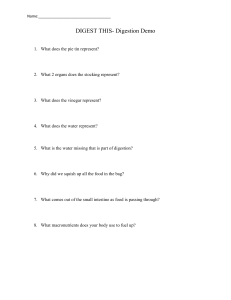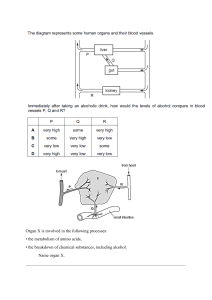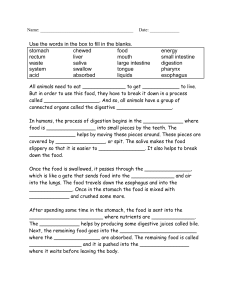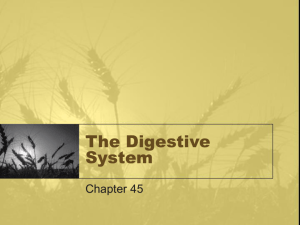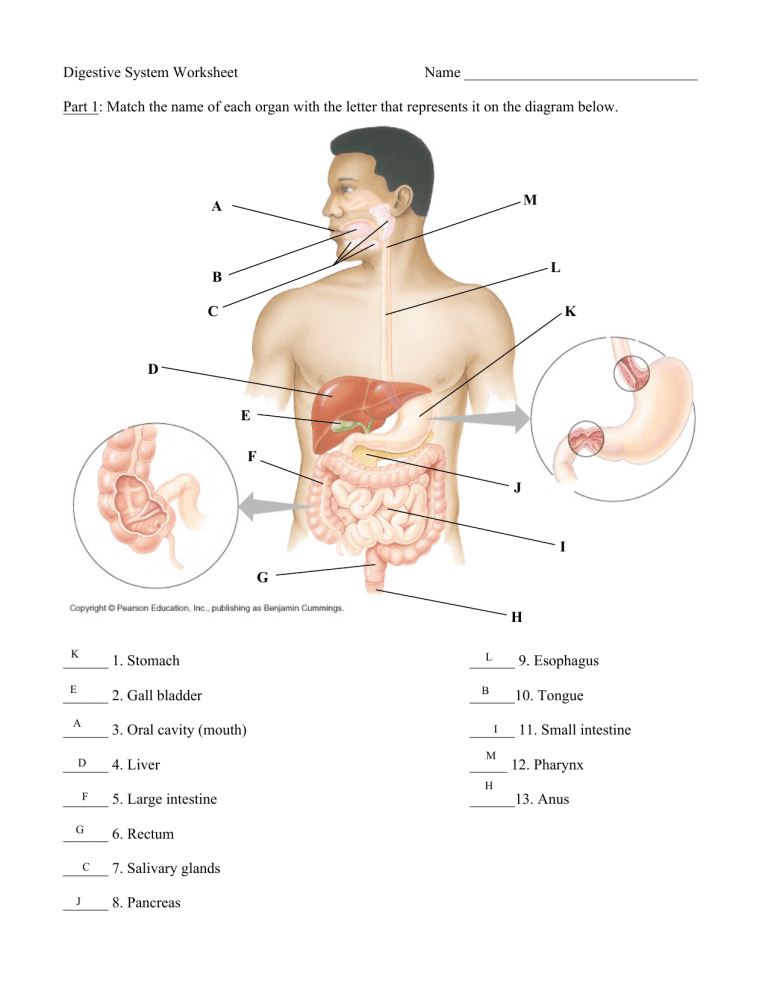
Digestive System Worksheet Name _______________________________ Part 1: Match the name of each organ with the letter that represents it on the diagram below. M A L B C K D E F J I G H K ______ 1. Stomach L ______ 9. Esophagus E ______ 2. Gall bladder B ______10. Tongue A ______ 3. Oral cavity (mouth) I ______ 11. Small intestine D ______ 4. Liver _____ 12. Pharynx F ______ 5. Large intestine ______13. Anus G ______ 6. Rectum C ______ 7. Salivary glands J ______ 8. Pancreas M H Part 2: Energy cells 1. Nutrients are a source of _____________ that your body uses for building tissues and ______________ for cellular work. 2. Name the four stages of food processing and describe what happens in each stage. Ingestion the taking in of food, Digestion the breaking down of food into nutrients, Absorption of nutrients through the small intestine , Secretion the removal of leftover items from the process of digestion. 3. Explain what peristalsis is. Peristalsis are a set of wave like muscle contractions, that help push around organs like the small intestine and stomach. 4. List the organs that are part of the alimentary canal. Motuh, Esophagus, Stomach, Small Intestine, Large Intestine, Rectum, Anus 5. Name 4 organs that are accessory glands or organs in the digestive system. Salivary Glands, Liver, Pancreas, and Galleblader Part 3: Using the key choices below, match the description given with the structure in the alimentary canal that it describes. Choices may be used more than once. A. Anus G. Microvilli L. Salivary Glands B. Appendix H. Mouth (Oral cavity) M. Small intestines C. Esophagus I. Pancreas N. Stomach D. Gallbladder J. Pharynx O. Tongue E. Large Intestines (Colon) K. Rectum P. Villi F. Liver D 1. Stores bile until it is secreted. ______ P 2. Fingerlike extensions in the intestinal wall that increase surface area ______ H, N 3. Two anatomical regions where mechanical digestion occurs. ______ O 4. Organ that mixes food in the mouth. ______ J 5. Common passage for food and air. ______ C 6. Literally a food chute; it has no digestive or absorptive role. ______ G 7. Projections of the plasma membrane of a cell that increase the cell’s surface area. ______ I 8.Produces a juice that neutralizes stomach acid and contains digestive enzymes. ______ ______ M 9. Organ responsible for absorption of most nutrients. E 10. Organ primarily involved in water absorption and feces formation. ______ B 11. Blind sac hanging from the initial part of the colon. ______ N 12. Organ in which protein digestion begins. ______ M 13. Organ into which the stomach empties. ______ M 14. Organ that receives pancreatic juice and bile. ______ A 15. Opening through which feces are expelled from the body. ______ F 16. Produces bile. ______ L 17. Produce enzymes that begin carbohydrate digestion. ______ K 18. Stores feces until they are excreted. ______ Part 4: Answer the following questions. 1. What is the end product starch digestion? Glucose 2. What is the end product protein digestion? amino acids 3. What is the end product fat digestion? fatty acids and glycerol 4. Where does starch digestion begin? mouth 5. Where is starch digestion completed? in the colon 6. Where does protein digestion begin? in the stomach 7. Where is protein digestion completed? small intestine 8. Where does fat digestion begin? stomach 9. Where is fat digestion completed? small intestine 10. Explain the difference between mechanical digestion and chemical digestion. With mechanical digestion, the chemical makeup of the molecule is not changed. While with chemical digestion its chemical makeup is changed. 11. Explain how the small intestines are well adapted for absorption. The small intestines are well adapted for absorption due to the fact that there are villi that line the insides of it, allowing for increased surface area which allows for nutrients to be absorbed faster.

